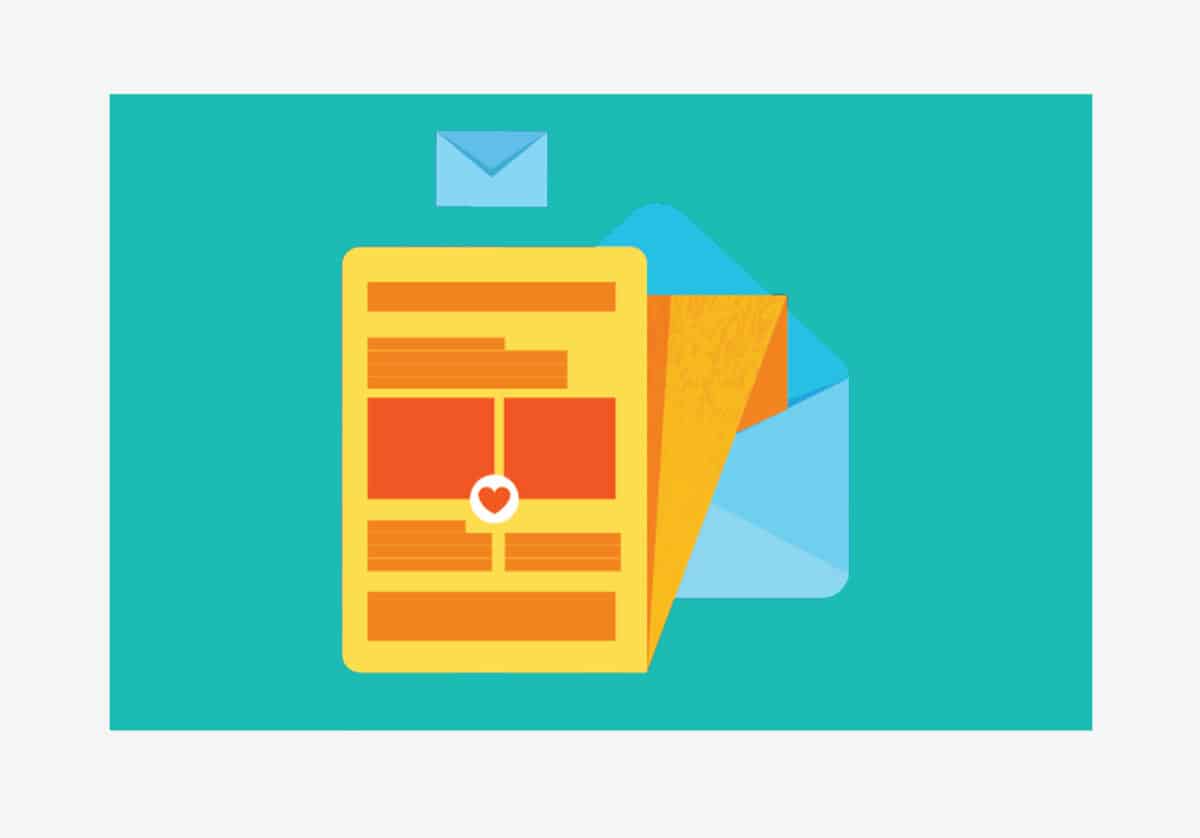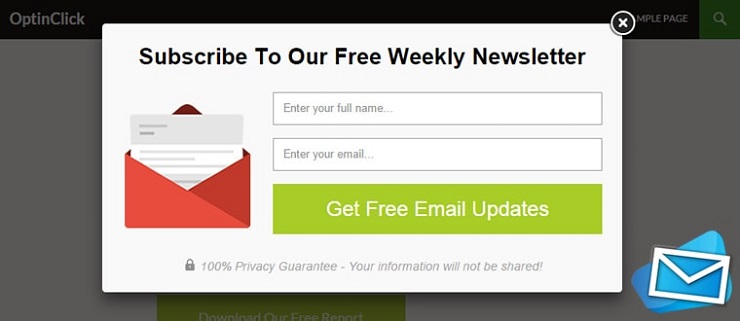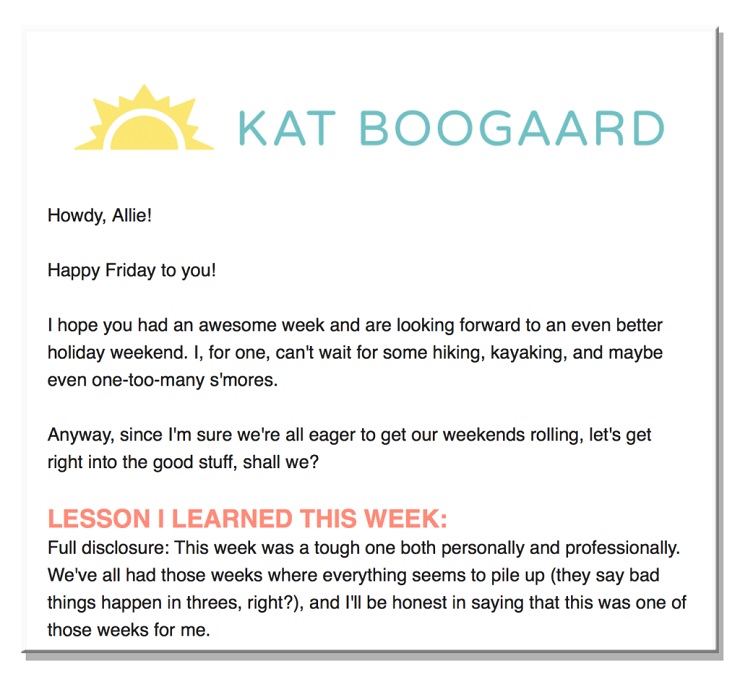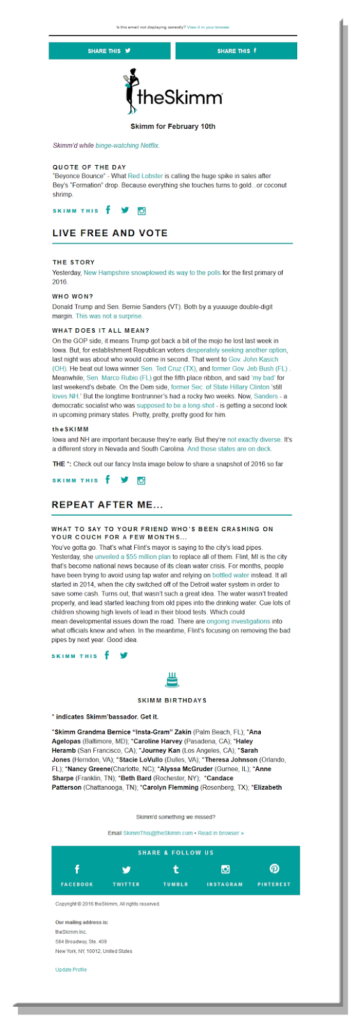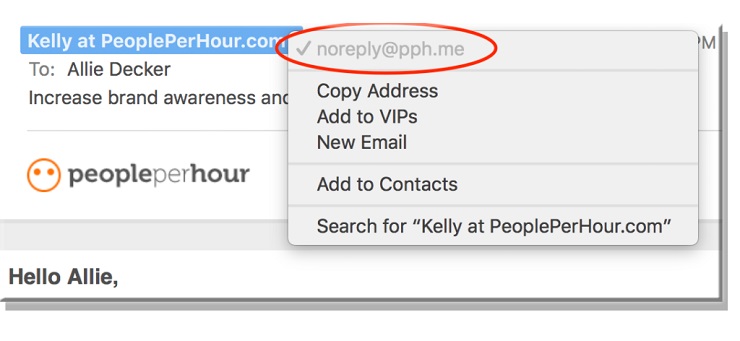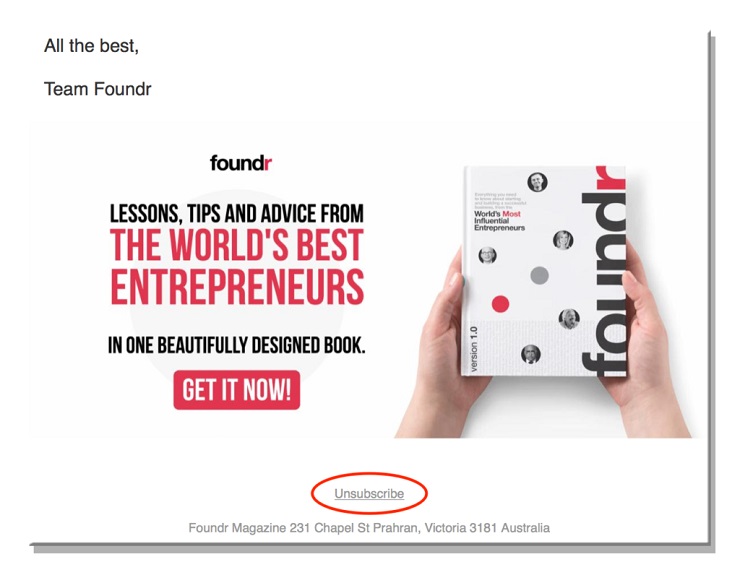There’s a handful of universal truths in life: Nothing beats a good Harry Potter book, sandwiches taste better when cut into triangles instead of squares, and over-eager email newsletters are the worst.
As a consumer, you know exactly how annoying email newsletters can be.
I’ve fretted so many times over a double-digit email notification, only to realize that more than half are bogus emails from companies I don’t recognize (or remember giving my email to).
On the other hand, as a marketer and an entrepreneur, you realize just how important email is. It’s probably the core of your marketing strategy, and if it’s not, it probably should be.
In fact, email marketing is not only the most effective tactic for nurturing customers, but it’s also proven to be 40 times more effective at acquiring new customers than Facebook or Twitter.
Emails are a valuable currency among small business owners. They provide a personal and relatable avenue through which you can connect with your audience and stay top-of-mind long after a purchase.
So, how do you make that leap from inbox annoyance and marketing gold? How do you create email content that people actually read, and even look forward to? I’ll show you here.
Let’s start with the why behind emails.
Why Email Remains the Workhorse of Online Marketing
Although email, compared to social media, blogging, and even texting, may seem like a vintage form of communication, it’s still very relevant and critical to your success as a small business.
Email is the most straightforward way to build an ongoing relationship with your audience.
Think about it. Social media and blogging require casting a general message out to thousands of users. Sure, you can communicate directly with users on social media, but this still requires logging into a network shared with millions of others, and one that most people don’t use as a primary form of one-on-one interaction.
Email, though you may send the same message to your entire audience, involves dropping a note into their private inbox, with a message that’s just for them.
It’s a way to knock on their digital front door and deliver a message, directly.
According to a Nielsen study on email marketing, readers actually feel an emotional attachment to their email newsletters. Results showed that newsletters feel especially personal, because they arrive in each subscriber’s inbox, allowing the subscriber to create and have an ongoing relationship with the company. This positive, reliable relationship can create a longer-lasting bond than a website can.
Your audience may not respond to your email newsletters as eagerly as Meg Ryan did to her You’ve Got Mail notification, but if written well, they’ll still be eager to read what you send.
A Small Business Can Live or Die by its Email
Email addresses are valuable among business owners, especially entrepreneurs. They’re key to attracting, converting, and recycling leads. When the world gets busy and loud, they keep your business at the forefront of your customer’s minds.
Email is nothing like other forms of digital marketing. Unlike a status update, a new email begs for attention, or at least conscious disposal. Unlike a blog post, SEO and search rankings don’t affect how often an email is seen. Acquiring someone’s email (if done ethically and legally) is a step closer to garnering their attention and pocketing their money. It’s a gesture that says, “I’m interested. Tell me more.”
Emails also add value to your business, if you ever considered selling or expanding. Growing and nurturing your email list adds people to a network that is solely yours. As Joe Pulizzi, founder of the Content Marketing Institute, says, “you can’t build your content on rented land (i.e. social media).” And email newsletters are the tool that’ll help you cultivate this list.
As commonly as businesses send and rely upon email newsletters, very few are done right. And by right, we mean created and managed in a way that actually excites your readers.
Here’s how to write a kickass email newsletter.
Consistency is Key
As boring as the word “newsletter” is, it does imply routine communication. Before committing to creating and sending out an email newsletter for your business, take stock of your general marketing responsibilities. Can you add another weekly or monthly content commitment to your list? If not, consider outsourcing your email marketing duties.
If your newsletter is done right—and by golly, we’ll do everything we can in this post to help you get there—your subscriber base will come to anticipate its regular arrival.
Meaning they’ll finally turn into Meg Ryan in You’ve Got Mail. How cool would that be? To be creating content so relevant and helpful that your audience is excited to receive it? That’s the goal here.
But those kinds of #emailgoals can only be achieved if you’re ready and willing to stick to a consistent schedule. Consistency not only helps your audience anticipate your emails, but it also contributes to building trust and authority among your readers. Lastly, routinely popping up in your readers’ inboxes ensures you won’t be forgotten after gaps in communication.
The perfect timing of email newsletters is a common question. Should you send them every week? Every month? Bi-monthly? Well, the answer really depends on what you can handle. Remember, great email newsletters share fresh, timely, informative content. If you want to send yours out every week, are you confident that you can produce brand new content at that pace?
Unless you run an active blog or content site, start by sending your newsletter monthly or bi-monthly. That will keep your name fresh with your subscribers while alleviating the pressure of creating new content. You can always increase the frequency of your communications.
To help you remember, consider adding your email marketing schedule to your social media content and/or blog calendars. That way, you’ll have all of your digital marketing activity in one place.
Inform, Don’t Sell
I’m sorry to break it to you, but your audience doesn’t want to hear about your products and services all the time.
Don’t be too upset. It’s true for everyone.
While your subscribers might love you (hence why they subscribed, we hope) and want to hear from you, there’s only so much selling you can do before they tune you out completely.
Instead of pushing sales and products, consider a more informative route. In fact, aim to make your newsletter 90% informative and 10% promotional. Better yet, make the informative portion conversational and authentic. Being real with your audience provides a breath of fresh air in a very stuffy, sales-ey world.
For example, I subscribe to a newsletter that one of my favorite writers sends out every Friday. Each week, she shares an educational blurb or tells a story about her clients or current projects. She also includes popular job listings and words of encouragement for other writers like myself. Once in awhile, she’ll talk about her paid courses or published books, but rarely does she push herself onto her subscribers. Because of that, her newsletter is one of a few that I not only look forward to but also open, every time.
Don’t be the company that sends emails screaming buy, buy, buy. Focus on relevant, helpful, timely content and save the self-promotion for when it really matters. In this case, less really is more.
Keep Email Newletters Short and Sweet, and Aim for a Clickthrough
The average time people allocate to reading one email newsletter is 51 seconds.
It takes me longer eat a triangle-cut sandwich, and those are the best.
Point is, people don’t read. Not only are general attention spans quickly waning (thanks, social media), but users are adopting a skim-all mentality. When reading email newsletters, they jump right to the juicy stuff, glancing through the main topics and skipping the introductions altogether.
What does that mean for you? As we said before, less is more.
Keep your introduction text short, if not removing it completely. Optimize and embolden your headlines and align your content on the left. Keep your paragraph content short, ideally fewer than 60-75 characters. These small formatting changes can make your emails way easier to scan.
Interest in email content diminishes below the fold, so prioritize your most important content by sticking it at the top.
Take theSkimm newsletter, for example. Their emails are always concise and clearly organized. They recognize that their target audience—young, professional women—hardly have time to stop and read a novel. So, they format their emails to ensure a quick scan will suffice (hence the name).
Lastly, don’t hesitate to include links to your website or social media pages. Always include calls-to-action like “Learn More,” “Read More,” or “Watch This Video.” This is a great first step to grabbing a new lead or even converting a subscriber. If done right, keeping your content concise can work in your favor. *wink*
Like we said above, a great email newsletter is like knocking on your audience’s digital front door, ready to deliver exciting news created just for them.
Picture Buddy the Elf receiving a ChristmasGram, but in email form. Bam. That’s #emailgoals if I’ve ever seen it.
Regardless of how many subscribers you have, understand that your newsletter will be received and read by each one, individually. You need to create your email newsletter experience with that in mind, and that means making your content as personal as possible.
Firstly, always speak in first- or second-person. Use “you,” “we,” and “I.” Don’t refer to your readers as “readers” or “subscribers,” as that can alienate your audience and distance yourself from them. As an entrepreneur and small business, your goal must always be to not lose your uniqueness and personality as a brand. Your email newsletter can help you retain this personality.
Second, consider the email address from which you send your email. Nothing’s worse than talking to a friend who isn’t listening, and sending your newsletter out with a “do not reply” email can send the wrong message to your subscribers. Aim to create a conversation with your emails, not a broadcast.
As an example, the image below is from a newsletter I received last week. Not only does the “noreply” make me feel like I’m one of a million (which I probably am, but I shouldn’t be reminded of that), but the lack of personal email address makes it seem like I’m communicating with a computer.
Allowing, and even encouraging, your readers to respond lets them know that there’s a living, breathing person on the other end. This is also a great avenue for receiving valuable feedback, criticism, and questions.
Leave Room to Break Up
No one enjoys a breakup. It’s a sad, messy situation, but in the midst of it, everyone tells you it’s better in the long-run.
The same goes for email marketing. (Sure, there aren’t too many similarities between human relationships and electronic mail, but we’ll run with this one.)
As fun as it is to connect and interact with your audience on a personal level, the ultimate goal of email marketing is to maintain an active, interested subscriber list. That means you want to keep your email marketing numbers as squeaky clean as possible. That means dropping dead weight.
Hiding or burying your Unsubscribe option, as tempting as it is, can actually hurt your email newsletter campaigns in the long run. If users can’t find a way to gracefully bow out, they’ll most likely send your email to the Spam box, skewing your delivery, open, and clickthrough rates.
If your subscribers aren’t happy, let them go! A clear Unsubscribe is valuable feedback, and your subscribers can always come back!
As important as it is to connect and grow with your audience through email, it’s also super important to understand, analyze, and implement changes based on your email marketing data. Numbers don’t lie, and email is hardly the exception.
Let’s Talk Subject Lines
Ah. The email subject line. Sadly, in this case, books (emails) are judged by their covers (subject lines). In fact, 33% of people decide whether to open an email based on the subject line alone.
I recently wrote an article about how I marketed my small business with a super tight marketing budget. In the article, I said, “If you choose to leverage emails, be gentle with your customers’ inboxes. Craft your email subject lines with grace and mystery…”
When I approach my email newsletters, I focus on the balance between elegance and intrigue, because I rarely see that among the mass of emails that flood my inbox—and subsequently, my Trash folder. Some scream “HURRY! FREE FOR A LIM-”, while others whisper “July Specials fro…”.
The first one seems too eager. The second one simply assumes I’m already interested.
Sadly, many businesses approach email newsletter subject lines in one of these two ways. Some believe that a great open rate relies on urgency and SHOUTY CAPITALS. Creating a sense of urgency and scarcity is an effective open tactic, but there’s a way to rope people in without mentally splitting their eardrums.
If you like the urgency/scarcity tactic, consider subject lines like:
- “Are you in or out?”
- “$5 today, $25 tomorrow”
- “Last call for…”
- “The free are almost gone!”
Subject lines like these have the potential to stir up enough curiosity without inciting high blood pressure.
On the other hand, many businesses have come to rely on the same subject line for each email, thinking that increasing familiarity is more important than creating interest. As tempting as this is, especially for a recurring newsletter, this tactic can get old fast.
Why? Because there’s no incentive to open that email right now. Also, it hinders your email from standing out among the inevitably crowded inbox.
Instead of going with the same subject line each month, spice it up with these tips:
- Use a call-to-action
- Give the reader a taste of what’s inside
- Ask a question
At the end of the day, great content can get lost behind a lousy subject line. Don’t fret if your first few aren’t awesome. Take a look at your open rate, practice and test a few new ones, and try again.
Conclusion
Building a personable, relatable, and effective email newsletter isn’t a simple process, but it’s the one digital marketing strategy that can help you create and maintain close relationships with your customers—an important feat for entrepreneurs and small businesses. Following the above advice can help you communicate value to your audience but also attract and convert priceless leads into paying customers.
What do you love or hate in an email newsletter? Do you have any other tips for communicating with subscribers via email? Share your thoughts with us in the comments below!
